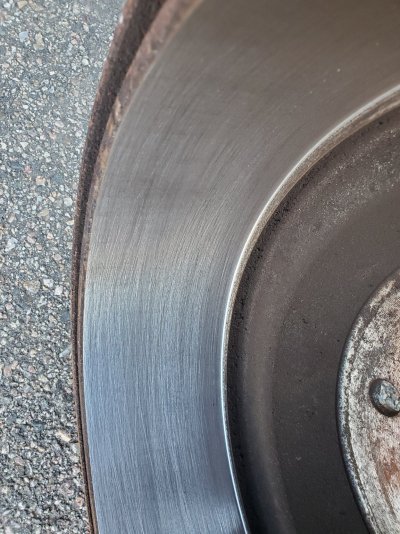Long-winded answer to a 'Q ' that could of been answered with a simple 'yes' or 'no'.
Got on a roll. A couple or 3, maybe 4(?), espresso's will do that. Bzzzt.
I've turned hundreds of drums. Yea. Hundreds. Rotors, too.
One of my duties working in a machine shop right outa school. 18 months. Some weeks, that would be ALL that I did! All day!
The Corporate rear end brake drums under 3/4 & 1 ton trucks were a PitA. Pretty heavy.
The drums from 2-5 ton trucks took two of us to mount on the machines. Stupid heavy!
The last part of the process was to scuff the machined surface, both drums & rotors, with some 100 grit before removing the drum from the lathe. The random cross-hatching helps to seat pads & shoes against the D&R's.
There was hell to pay if I short-cutted and skipped that step.
D&R's don't get machined as much any more. Easier to toss & replace because of those off-shore producer's cheap-cheap prices.
That also means that they're made cheap! Recycled steel with lots of foreign matter, plus a lower nickel content than those of 30-40 years ago.
It's the nickel content that gives the steel it's strength, durability & resistance to repeated heat cycles. Without that content, the Chinesium parts don't last. Too soft. The pads & shoes eat 'em up, especially with high friction pads/shoes.
They are also prone to warping. Can't take the heat. They really don't like extended periods of towing or canyon carving antics.
Even the OEM GM-labelled D&R's are off-shore-made now-a-days.
Junk.
I'm hard on brakes. A set of the jobber rotors lasts me about 8 months. So warped, hard braking would shake the S/wheel almost out of my hands. $60.00/pair.
After 20 years of owning 400's, I've gotten pretty good at doing brake jobs on em. It was getting expensive, though.
So...I bought some aftermarket U.S. Made rotors/pads, drums/shoes. The rotors/pads were close to (!) $400.
But they lasted for 9 years. 2 sets of pads & 2 turnings.
That's less than $50.00/year.
The jobbers were costing $90.00/year + pads.
Even still, no matter how much the parts cost, I always, ALWAYS, get new D&R's machined right outa the box. They go from the parts counter up front to the machine shop out back so there's absolutely no doubt.
I've had some that were so warped straight from the parts store that they could not be turned. So outa whack that by the time the surface was cut down to be nice & even all the way around, they were beyond the max cut spec.
I've returned as many as 3 sets drums & 2 sets of rotors in a row right back to the front counter before I even left the building.
When the machine shop guys brought the U.S. Made stuff back, they told me that they were damn near perfect right out of the box. They were surprised.
I also test fit the brake shoes against the newly turned drums. A check to determine if the shoes need to be arced. A process that matches the brake shoe's curvature to the drum's for best contact.
Anyways...the coffee cup's empty. 1 more? Hmmm...
Better check the B/P first.


